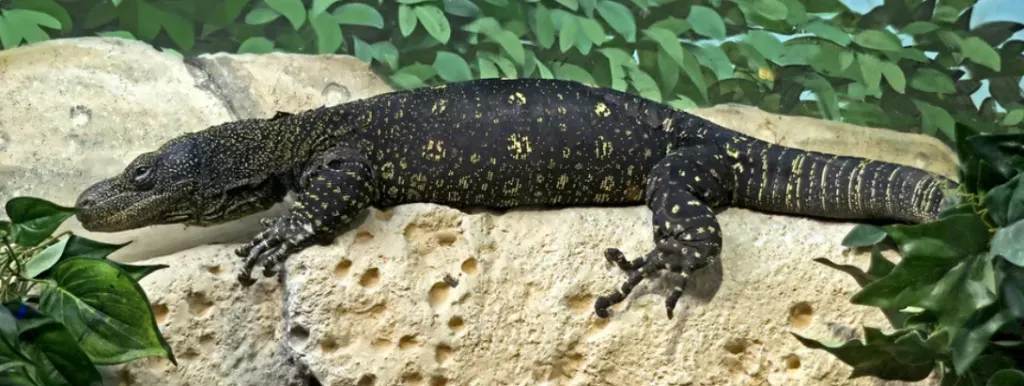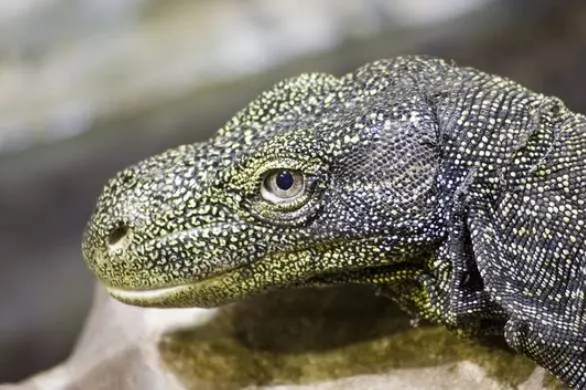The Crocodile Monitor, scientifically known as Varanus salvadorii, is a fascinating reptile that has intrigued researchers and animal enthusiasts alike. Native to the lush, dense forests of New Guinea, this monitor lizard is one of the largest and most remarkable species within the Varanidae family. With a reputation for its immense size, distinctive appearance, and aggressive nature, the Crocodile Monitor holds a special place in the world of reptiles.

Table of Contents
Physical Characteristics
The Crocodile Monitor is an extraordinary example of nature’s ability to create highly specialized creatures. Reaching lengths of up to 8.86 feet (2.7 meters) and sometimes even more, this species is the longest of all monitor lizards. However, despite their length, they are relatively lightweight, weighing between 11 and 13.2 pounds (5 to 6 kilograms). This gives them a slender, svelte appearance that is well-adapted to their arboreal lifestyle.
One of the most distinctive features of the Crocodile Monitor is its incredibly long tail, which can be twice the length of its body. This tail is not just for show; it serves multiple purposes, including balance while climbing, self-defense, and as a tool for whipping potential threats. Their bodies are adorned with black scales interspersed with yellow, green, or white spots and stripes, providing effective camouflage in the dappled light of the forest canopy.
Their snouts are another unique characteristic, with a pronounced bulge and a high head. The teeth of the Crocodile Monitor are large, flat, and serrated, adapted to tearing into prey with ease. Unlike many other monitor lizards, their teeth are better suited for capturing and consuming larger animals.
Habitat and Distribution
Crocodile Monitors are endemic to the island of New Guinea, where they inhabit lowland rainforests, coastal mangrove swamps, and riparian woodlands. These environments provide the dense foliage and towering trees that the species relies on for shelter and hunting grounds. Their arboreal nature makes them expert climbers, spending much of their time in the treetops, though they do come down to the ground or even underwater to sleep.
Despite their formidable size and aggressive nature, Crocodile Monitors are elusive and prefer to avoid human contact. Their remote and largely inaccessible habitat, combined with their solitary lifestyle, makes them difficult to study in the wild. As a result, much about their behavior and ecology remains a mystery.
Diet and Hunting Strategies
Crocodile Monitors are apex predators with a diet that reflects their position at the top of the
Interestingly, there are reports suggesting that Crocodile Monitors may also engage in scavenging behavior, although this is not well-documented. In captivity, they have been observed eating chicks, quail, mice, and small rats. However, due to their reclusive nature and the difficulty in observing them in their natural habitat, much about their feeding habits in the wild remains speculative.
Behavior and Temperament
The Crocodile Monitor is known for its aggressive demeanor, a trait that has earned it a fearsome reputation. They are solitary creatures, only coming together during the breeding season. They are also diurnal, meaning they are most active during the day.
One of the more remarkable aspects of their behavior is their use of their tail for self-defense. When threatened, a Crocodile Monitor will lash out with its tail, which can deliver a powerful and painful strike to any would-be attacker. Additionally, their teeth are not only adapted for hunting but also serve as a formidable defense mechanism. Bites from a Crocodile Monitor can be dangerous, not just because of the physical damage but also due to the potential for infection, as their saliva contains harmful bacteria.
Unlike some other monitor lizards, Crocodile Monitors are not known for their venom. While there is some debate about the presence of venom in monitor lizards generally, the consensus is that any toxic effects from a Crocodile Monitor’s bite are more likely due to bacterial infection rather than venom.
Reproduction and Lifespan
Crocodile Monitors have a relatively slow reproductive rate compared to other reptiles. Females reach sexual maturity at about two years of age, while males take around three years. Mating can occur throughout the year, though it may be more common during the onset of spring or autumn in higher latitudes.
Females lay between 4 to 12 eggs per clutch, with up to three clutches per year. The incubation period for these eggs is quite lengthy, ranging from 155 to 251 days, depending on environmental conditions such as temperature. Hatchlings are relatively large, measuring up to 18 inches (46 cm) and weighing about 2.12 ounces (60 g).
In captivity, Crocodile Monitors have been known to live up to 20 years. However, their lifespan in the wild is less well-documented, primarily due to the challenges of studying them in their natural environment.

Conservation Status and Threats
Currently, the Crocodile Monitor is listed as “Least Concern” on the IUCN Red List, indicating that the species is not immediately at risk of extinction. However, they face significant threats from habitat loss due to deforestation and hunting by local populations for their skin and meat. While they are protected under CITES Appendix II, which restricts international trade, these protections are not always effectively enforced, particularly in Indonesia where the species is not legally protected.
The continued survival of the Crocodile Monitor depends largely on the preservation of their natural habitat and stricter enforcement of hunting regulations. As an apex predator, they play a crucial role in maintaining the balance of their ecosystem, and their loss could have far-reaching consequences for the biodiversity of New Guinea.
The Crocodile Monitor is a remarkable example of evolution’s ability to produce highly specialized and efficient predators. Their unique physical characteristics, aggressive behavior, and elusive nature make them a fascinating subject for study and admiration. However, the threats they face from human activities highlight the need for continued conservation efforts to ensure that this incredible species continues to thrive in the wild.
- Enchi Ball Python: A Unique and Stunning Morph of Python regius - March 27, 2025
- Emerald Tree Monitor: The Enigmatic Green Guardian of the Rainforest - March 26, 2025
- The Egyptian Cobra (Naja haje): A Fascinating Serpent - March 25, 2025
